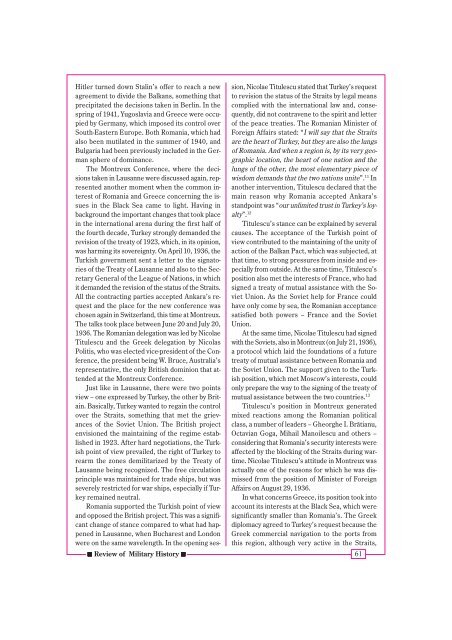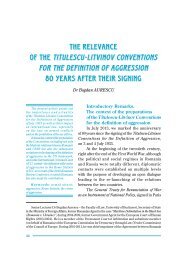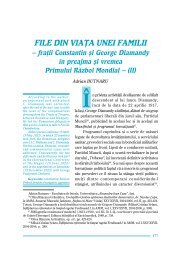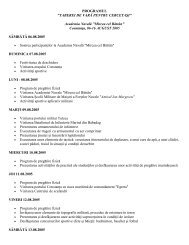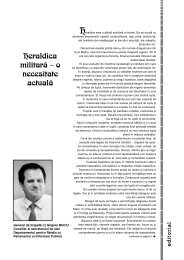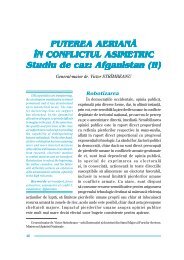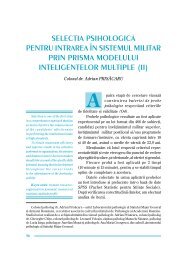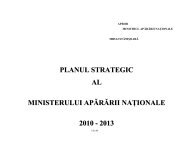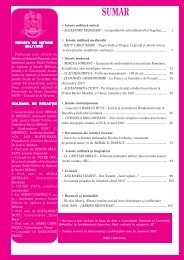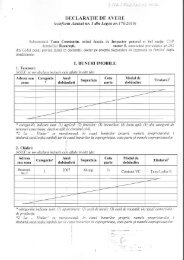You also want an ePaper? Increase the reach of your titles
YUMPU automatically turns print PDFs into web optimized ePapers that Google loves.
Hitler turned down Stalin’s offer to reach a new<br />
agreement to divide the Balkans, something that<br />
precipitated the decisions taken in Berlin. In the<br />
spring of 1941, Yugoslavia and Greece were occupied<br />
by Germany, which imposed its control over<br />
South-Eastern Europe. Both Romania, which had<br />
also been mutilated in the summer of 1940, and<br />
Bulgaria had been previously included in the German<br />
sphere of dominance.<br />
The Montreux Conference, where the decisions<br />
taken in Lausanne were discussed again, represented<br />
another moment when the common interest<br />
of Romania and Greece concerning the issues<br />
in the Black Sea came to light. Having in<br />
background the important changes that took place<br />
in the international arena during the first half of<br />
the fourth decade, Turkey strongly demanded the<br />
revision of the treaty of 1923, which, in its opinion,<br />
was harming its sovereignty. On April 10, 1936, the<br />
Turkish government sent a letter to the signatories<br />
of the Treaty of Lausanne and also to the Secretary<br />
General of the League of Nations, in which<br />
it demanded the revision of the status of the Straits.<br />
All the contracting parties accepted Ankara’s request<br />
and the place for the new conference was<br />
chosen again in Switzerland, this time at Montreux.<br />
The talks took place between June 20 and July 20,<br />
1936. The Romanian delegation was led by Nicolae<br />
Titulescu and the Greek delegation by Nicolas<br />
Politis, who was elected vice-president of the Conference,<br />
the president being W. Bruce, Australia’s<br />
representative, the only British dominion that attended<br />
at the Montreux Conference.<br />
Just like in Lausanne, there were two points<br />
view – one expressed by Turkey, the other by Britain.<br />
Basically, Turkey wanted to regain the control<br />
over the Straits, something that met the grievances<br />
of the Soviet Union. The British project<br />
envisioned the maintaining of the regime established<br />
in 1923. After hard negotiations, the Turkish<br />
point of view prevailed, the right of Turkey to<br />
rearm the zones demilitarized by the Treaty of<br />
Lausanne being recognized. The free circulation<br />
principle was maintained for trade ships, but was<br />
severely restricted for war ships, especially if Turkey<br />
remained neutral.<br />
Romania supported the Turkish point of view<br />
and opposed the British project. This was a significant<br />
change of stance compared to what had happened<br />
in Lausanne, when Bucharest and London<br />
were on the same wavelength. In the opening ses-<br />
����� Review of Military History �����<br />
sion, Nicolae Titulescu stated that Turkey’s request<br />
to revision the status of the Straits by legal means<br />
complied with the international law and, consequently,<br />
did not contravene to the spirit and letter<br />
of the peace treaties. The Romanian Minister of<br />
Foreign Affairs stated: “I will say that the Straits<br />
are the heart of Turkey, but they are also the lungs<br />
of Romania. And when a region is, by its very geographic<br />
location, the heart of one nation and the<br />
lungs of the other, the most elementary piece of<br />
wisdom demands that the two nations unite”. 11 In<br />
another intervention, Titulescu declared that the<br />
main reason why Romania accepted Ankara’s<br />
standpoint was “our unlimited trust in Turkey’s loyalty”.<br />
12<br />
Titulescu’s stance can be explained by several<br />
causes. The acceptance of the Turkish point of<br />
view contributed to the maintaining of the unity of<br />
action of the Balkan Pact, which was subjected, at<br />
that time, to strong pressures from inside and especially<br />
from outside. At the same time, Titulescu’s<br />
position also met the interests of France, who had<br />
signed a treaty of mutual assistance with the Soviet<br />
Union. As the Soviet help for France could<br />
have only come by <strong>sea</strong>, the Romanian acceptance<br />
satisfied both powers – France and the Soviet<br />
Union.<br />
At the same time, Nicolae Titulescu had signed<br />
with the Soviets, also in Montreux (on July 21, 1936),<br />
a protocol which laid the foundations of a future<br />
treaty of mutual assistance between Romania and<br />
the Soviet Union. The support given to the Turkish<br />
position, which met Moscow’s interests, could<br />
only prepare the way to the signing of the treaty of<br />
mutual assistance between the two countries. 13<br />
Titulescu’s position in Montreux generated<br />
mixed reactions among the Romanian political<br />
class, a number of leaders – Gheorghe I. Brătianu,<br />
Octavian Goga, Mihail Manoilescu and others –<br />
considering that Romania’s security interests were<br />
affected by the blocking of the Straits during wartime.<br />
Nicolae Titulescu’s attitude in Montreux was<br />
actually one of the reasons for which he was dismissed<br />
from the position of Minister of Foreign<br />
Affairs on August 29, 1936.<br />
In what concerns Greece, its position took into<br />
account its interests at the Black Sea, which were<br />
significantly smaller than Romania’s. The Greek<br />
diplomacy agreed to Turkey’s request because the<br />
Greek commercial navigation to the ports from<br />
this region, although very active in the Straits,<br />
61


